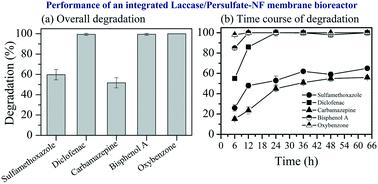当前位置:
X-MOL 学术
›
Environ. Sci.: Water Res. Technol.
›
论文详情
Our official English website, www.x-mol.net, welcomes your feedback! (Note: you will need to create a separate account there.)
Elucidating the performance of an integrated laccase- and persulfate-assisted process for degradation of trace organic contaminants (TrOCs)
Environmental Science: Water Research & Technology ( IF 5 ) Pub Date : 2020-02-06 , DOI: 10.1039/c9ew01022j Muhammad B. Asif 1, 2, 3, 4, 5 , Jason P. van de Merwe 5, 6, 7 , Frederic D. L. Leusch 5, 6, 7 , Biplob K. Pramanik 5, 8, 9, 10 , William E. Price 1, 3, 4, 5, 11 , Faisal I. Hai 1, 2, 3, 4, 5
Environmental Science: Water Research & Technology ( IF 5 ) Pub Date : 2020-02-06 , DOI: 10.1039/c9ew01022j Muhammad B. Asif 1, 2, 3, 4, 5 , Jason P. van de Merwe 5, 6, 7 , Frederic D. L. Leusch 5, 6, 7 , Biplob K. Pramanik 5, 8, 9, 10 , William E. Price 1, 3, 4, 5, 11 , Faisal I. Hai 1, 2, 3, 4, 5
Affiliation

|
Laccase-catalysed degradation is a promising technology for the degradation of trace organic contaminants (TrOCs). However, depending on their physicochemical properties (e.g., chemical structures), non-phenolic TrOCs appear to be resistant to laccase-catalysed degradation, thus requiring an additional treatment process. In this study, the performance of an integrated laccase and persulfate (PS) mediated oxidation process was explored and elucidated for the first time. Compared to that achieved during treatment with laccase alone, the addition of PS at 1–10 mM concentration into batch enzymatic bioreactors showed concentration-dependent improvement in the degradation of the five TrOCs selected, namely diclofenac, sulfamethoxazole, carbamazepine, bisphenol A and oxybenzone. The results obtained from a series of batch tests also confirmed that the structural components (e.g., carbohydrate moieties in the enzyme) as well as the possibility of PS acting as a final acceptor of electrons from the type II and type III active sites of laccase may have led to PS activation. A continuous treatment system was developed by integrating a nanofiltration (NF) membrane with the laccase/PS process (NF-MBRlaccase/PS), which achieved TrOC-specific degradation. Importantly, the degradation of non-phenolic TrOCs (diclofenac, sulfamethoxazole and carbamazepine) further improved by 10 to 65% in the NF-MBRlaccase/PS system. This improvement could be attributed to: (i) the prolonged contact time between laccase/PS and TrOCs, which was possible due to their complete retention by the NF membrane; and (ii) retention of oxidative cross coupling agents or secondary radicals enhancing TrOC degradation. The NF membrane not only retained the moderately degraded carbamazepine and sulfamethoxazole effectively but also effectively removed toxic transformation products and residual estrogenicity of the final effluent as evaluated by cytotoxicity and estrogenicity assays, respectively. These observations indicate the significance of the high retention membrane in the NF-MBRlaccase/PS system for producing high quality permeate suitable for disposal and potentially for water reuse applications.
中文翻译:

阐明漆酶和过硫酸盐辅助的集成工艺降解痕量有机污染物(TrOCs)的性能
漆酶催化的降解是降解痕量有机污染物(TrOCs)的有前途的技术。但是,取决于它们的理化特性(例如,化学结构),非酚TrOC似乎对漆酶催化的降解具有抵抗力,因此需要额外的处理过程。在这项研究中,首次探索并阐明了整合漆酶和过硫酸盐(PS)介导的氧化过程的性能。与仅用漆酶处理期间获得的结果相比,在批次酶促生物反应器中添加1-10 mM浓度的PS表现出浓度依赖性的改善了所选择的5种TrOC的降解,即双氯芬酸,磺胺甲恶唑,卡马西平,双酚A和氧苯甲酮。从一系列批次测试获得的结果还证实了结构组件(例如,酶中的碳水化合物部分)以及PS充当漆酶II型和III型活性位点电子的最终受体的可能性可能导致PS活化。通过将纳滤膜与漆酶/ PS工艺(NF-MBR漆酶/ PS)整合在一起,开发了一种连续处理系统,该工艺实现了TrOC特异性降解。重要的是,NF-MBR漆酶/ PS中非酚类TrOCs(双氯芬酸,磺胺甲恶唑和卡马西平)的降解进一步提高了10%至65%系统。这种改善可以归因于:(i)漆酶/ PS和TrOCs之间的接触时间延长,这可能是由于它们被NF膜完全保留了;(ii)保留氧化交联剂或辅助自由基以增强TrOC降解。NF膜不仅有效保留了中度降解的卡马西平和磺胺甲恶唑,而且分别通过细胞毒性和雌激素测定法评估,有效去除了毒性转化产物和最终流出物的残留雌激素性。这些观察结果表明,在NF-MBR漆酶/ PS系统中,高截留率膜对于生产适用于处理并可能用于水再利用的高质量渗透液的重要性。
更新日期:2020-02-06
中文翻译:

阐明漆酶和过硫酸盐辅助的集成工艺降解痕量有机污染物(TrOCs)的性能
漆酶催化的降解是降解痕量有机污染物(TrOCs)的有前途的技术。但是,取决于它们的理化特性(例如,化学结构),非酚TrOC似乎对漆酶催化的降解具有抵抗力,因此需要额外的处理过程。在这项研究中,首次探索并阐明了整合漆酶和过硫酸盐(PS)介导的氧化过程的性能。与仅用漆酶处理期间获得的结果相比,在批次酶促生物反应器中添加1-10 mM浓度的PS表现出浓度依赖性的改善了所选择的5种TrOC的降解,即双氯芬酸,磺胺甲恶唑,卡马西平,双酚A和氧苯甲酮。从一系列批次测试获得的结果还证实了结构组件(例如,酶中的碳水化合物部分)以及PS充当漆酶II型和III型活性位点电子的最终受体的可能性可能导致PS活化。通过将纳滤膜与漆酶/ PS工艺(NF-MBR漆酶/ PS)整合在一起,开发了一种连续处理系统,该工艺实现了TrOC特异性降解。重要的是,NF-MBR漆酶/ PS中非酚类TrOCs(双氯芬酸,磺胺甲恶唑和卡马西平)的降解进一步提高了10%至65%系统。这种改善可以归因于:(i)漆酶/ PS和TrOCs之间的接触时间延长,这可能是由于它们被NF膜完全保留了;(ii)保留氧化交联剂或辅助自由基以增强TrOC降解。NF膜不仅有效保留了中度降解的卡马西平和磺胺甲恶唑,而且分别通过细胞毒性和雌激素测定法评估,有效去除了毒性转化产物和最终流出物的残留雌激素性。这些观察结果表明,在NF-MBR漆酶/ PS系统中,高截留率膜对于生产适用于处理并可能用于水再利用的高质量渗透液的重要性。


























 京公网安备 11010802027423号
京公网安备 11010802027423号